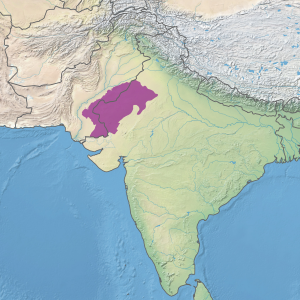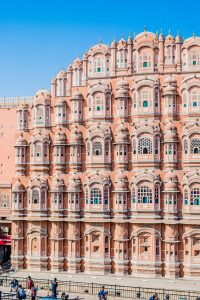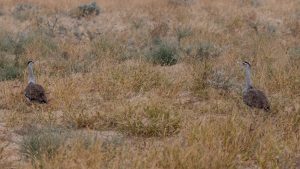75 South Asia: Physical Geography – Thar Desert
The Thar Desert is located in western India and does extend across the border, so that Pakistan has about 15% of this desert. Ranking in the top twenty deserts by area, the Thar Desert is about 77 thousand square miles, about the size of Nebraska or South Dakota. As a hot sub-tropical desert, it is placed in the BWh Koppen climate classification.
T is for 30°
The Thar Desert was created by the 30° latitude desert building process. The mid-major climate zone around 30° N or S latitude is a climate region that features high air pressure. The high air pressure does not allow the rising air patterns that cause the cooling air temperatures and subsequent precipitation. The 30° north latitude line crosses the northern portion of the Thar Desert. Monsoon winds that bring rain to much of India instead mostly pass to the east of this desert. Of course, by definition rainfall is uncommon in the desert, producing 5-20 inches a year with most of the precipitation coming from the fringes of the monsoon rains common in most regions of India.

H is for Habitable
Deserts generally appear inhospitable. Humans need water to survive, yet a shortage of water via precipitation is the defining characteristic of deserts. Strikingly, the Thar Desert is the most densely populated desert in the world. With over 16 million people living in this desert, there is a population density of about 215 people per square mile.
Undulating sand dunes are common in the Thar Desert; however, other portions of the desert have soils that are suitable for agriculture, if sufficient water would be available. In fact, this water generally is supplied by irrigation canals, including the major Indira Gandhi Canal (formerly the Rajasthan Canal), the longest canal in India. With branching canals, it measures about 400 miles in length. Wheat and cotton are widely grown, while animals are herded, including enough sheep to make the Thar Desert the focal point of wool production in India. Upon rainstorms, the Thar Desert produces lush green vegetation for short periods of time.
A is for Anonymous
Anonymous to Americans, probably. Ask an American to name a desert. Certainly, most Americans would cite the Sahara Desert. Other answers might include the Gobi Desert, the Mojave Desert, the Kalahari Desert, or the Arabian Desert. Americans likely realize that Australia has deserts, while understanding that locations in Pakistan and Afghanistan include desert landscapes. Do Americans realize that India has some desert places? Maybe not and certainly few Americans could name the Thar Desert, even by its alternate name – the Great Indian Desert. Anonymous to Americans, but important to South Asians.
R is for Rajasthan

A majority of this desert land jurisdictionally belongs in the Indian state Rajasthan. By area at 132,139 square miles, Rajasthan is the largest state in India. It ranks 7th in population with over 70 million people. Its largest city Jaipur has over three million people. The place name Rajasthan is a portmanteau of raj (king) and sthana (land) in Sanskrit – thus king’s land or land of kings. With such a dry landscape, it is striking that this state should have such a prominent size and importance in India.
By the way, in Pakistan the Thar Desert is primarily in the Sindh Province and holds over six million livestock.
Did you know?
The place name Thar comes from thul, a term for the sand ridges found in the desert there.
India’s first test of a nuclear weapon was done in the Thar Desert in 1974.
The city Jaipur is the setting for the film The Best Exotic Marigold Hotel and its sequel.

The great Indian bustard is an endangered, large (one meter tall) ground bird found in the Thar Desert, among other places.
Cited and additional bibliography:
Allam, Ashish. HawaMahal, Jaipur , India. 18 February 2019. https://unsplash.com/photos/LVmwwo4I0As.
Beautiful World. “Thar Desert Facts & Information – Indian Desert Map | Travel Guide.” Facts & Information – Beautiful World Travel Guide, 4 Aug. 2018, https://www.beautifulworld.com/asia/india/thar-desert/.
Every-leaf-that-trembles, Thar Desert. CC BY-SA 4.0 <https://creativecommons.org/licenses/by-sa/4.0>, via Wikimedia Commons. https://upload.wikimedia.org/wikipedia/commons/3/37/Ecoregion_IM1304.png
Genani, Manoj. “The Thar Desert Blooms in Pakistan.” The Third Pole, https://www.thethirdpole.net/en/climate/thar-desert-pakistan/. Attribution 2.0 Generic (CC BY 2.0).
Prince, Mike. Great Indian Bustard. photo, 24 Nov. 2020. Flickr, https://www.flickr.com/photos/mikeprince/50862545631/.


